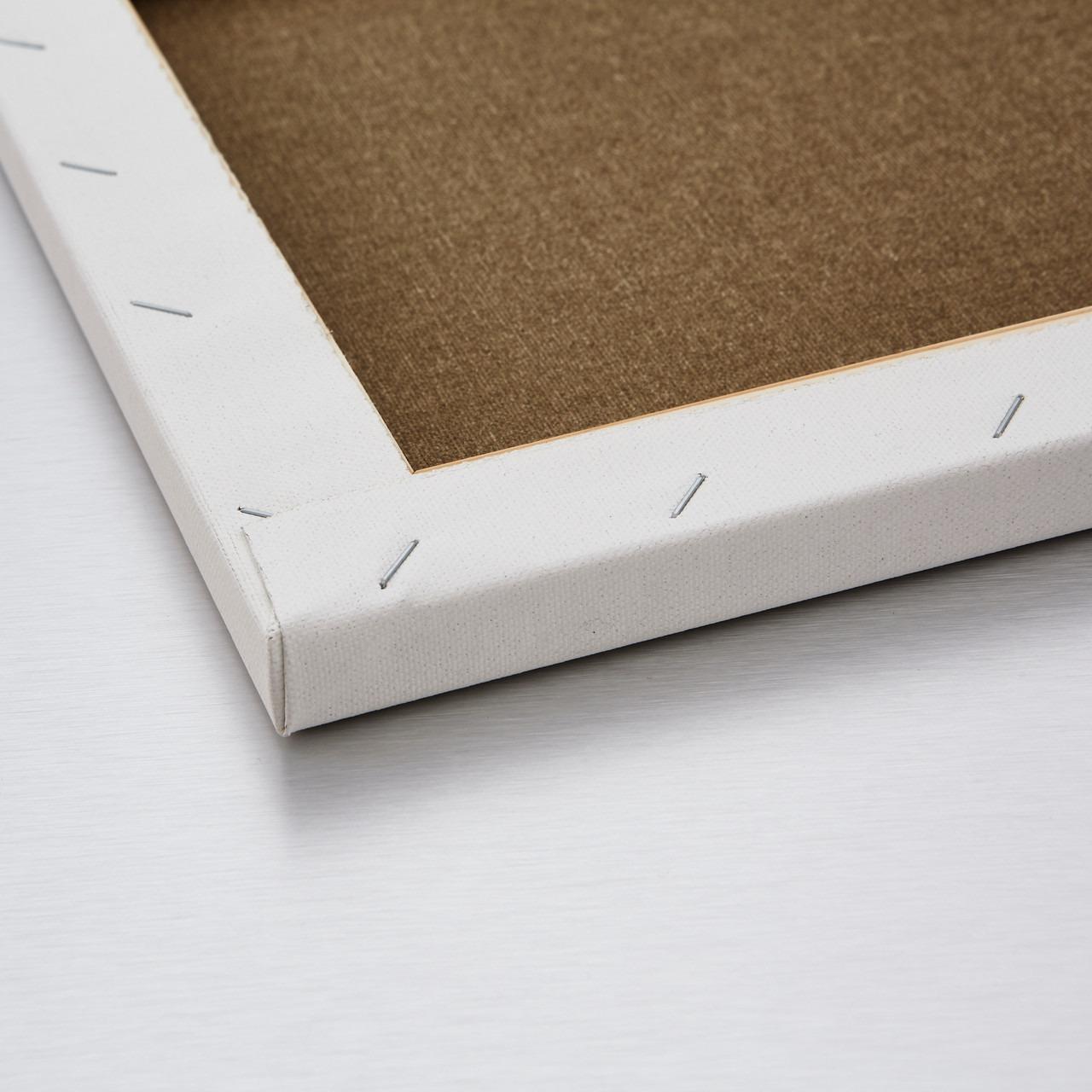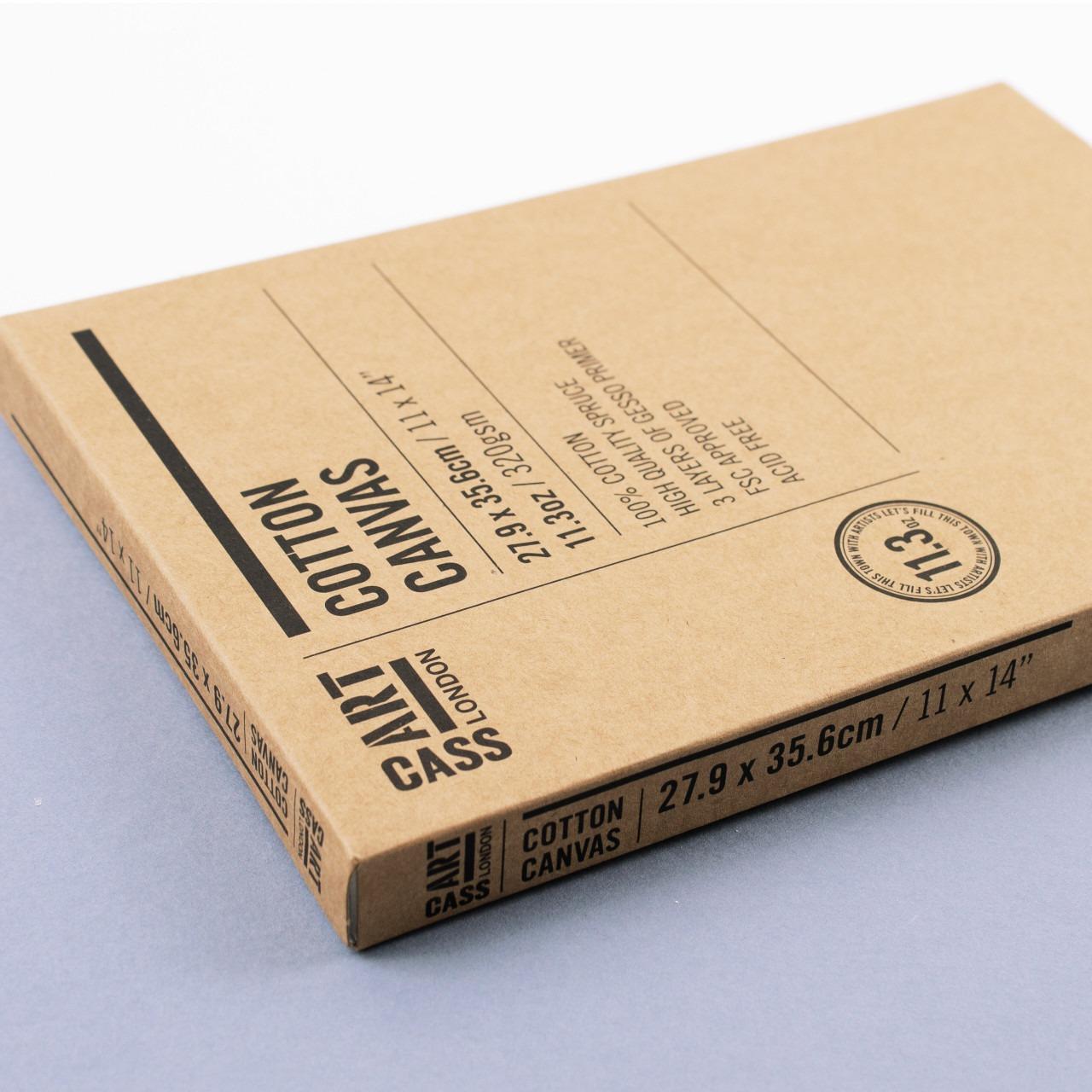

Our Cass Art Artists Cotton Canvas is made from high quality European spruce wood and 100% rayon cotton. Made from the highest-quality spruce wood and 100% pure cotton, this exhibition grade, European made, medium grain canvas has been produced for use with all forms of oil and acrylic colour, as well as many other mixed media applications. These canvases are also primed with three layers of gesso primer, FSC approved and acid free. Various sizes available, 1.9cm / 0.75 inches deep. It's a heavyweight canvas so weighs at 335gsm / 11.8oz. They are sold in packs online but available individually in stores.
- Made from the highest-quality spruce wood and 100% pure cotton, this exhibition grade, European made, medium grain canvas has been produced for use with all forms of oil and acrylic colour, as well as many other mixed media applications.
- These canvases are also primed with three layers of gesso primer, FSC approved and acid free.
- Various sizes available, 1.9cm / 0.75 inches deep.
- It's a heavyweight canvas so weighs at 335gsm / 11.8oz.
- They are sold in packs online but available individually in stores.
CASS ART COTTON 11.3oz CANVAS
This range comes in 2 different depths - 1.9cm and Deep Edge 3.8cm. They are made from high quality spruce wood and 100% pure cotton. This medium grain canvas has been produced for use with all forms of oil and acrylic colour, as well as many other mixed media applications.


- These canvas are also primed with three layers of gesso primer, FSC approved and acid free.
- They are sold in packs online but available individually in stores.
- The canvas range in size and are 1.9cm / 0.75 inches deep. The canvas heavyweight at 320gsm / 11.3oz.
- The Deep Edge range in size and are 3.8cm / 1.5 inches deep. The canvas heavyweight also at 320gsm / 11.3oz.
ARTISTS LINEN CANVAS
Linen is made from flax and considered to be superior to cotton due to strength and durability. It is not super absorbent by nature like cotton is and is less prone to expand and contract due to moisture. It is able to retain its natural oil content, which preserves the fibre’s long-term flexibility.


- Cass Art Artists Natural Linen Canvas is made from high quality European spruce wood and 100% pure flax linen.
- Made from the highest-quality spruce wood and 100% pure flax linen, this exhibition grade, European made, medium grain, clear primed canvas has been produced for use with all forms of oil and acrylic colour, as well as many other mixed media applications.
- These canvases are primed, FSC approved and acid free.
- They are sold in packs online but available individually in stores. The canvas range in size and are 2cm / 0.79 inches deep.
- The canvas heavyweight at 320gsm / 11.3oz.
CANVAS BOARDS
Canvas board is the term used for when a canvas is attached and glued to a rigid surface, in most cases wood. They are wrapped around the board and glued to the reverse, whereas boards have canvas glued to the front only, with shear edges. They are perfect for both quick sketches and more accomplished finished pieces


Our new range of Cass Art Canvas Board provide a high-quality alternative to using stretched canvas. They are durable and more portable making them perfect for al fresco painting. These canvas boards are triple-gesso primed, with a medium grain surface making them perfect for all forms of Oil, Acrylic and mixed media applications.
- High quality, dependable alternative to using stretched canvas.
- Triple Gesso Primed.
EXPLORE THE FULL RANGE OF CASS ART STRETCHED CANVASES HERE
CANVAS ROLLS AND STRETCHER BARS
A lot of artists prefer to make their own canvases to their own specifications, so If you're struggling to find the right length, width or depth, in the one canvas we also have canvas rolls and stretcher bars available to meet your needs too! There are a couple of things to consider when choosing your ideal canvas and stretcher bars.
WEAVE
Canvas is measured in grams per square metre (or gsm as you'll commonly see) or ounces per square yard (oz). If the cotton or linen has a heavy weight then one or both of the following is true: it is a thick, tough yarn and/or it is tightly woven. Lightweight cotton or linens have an open weave and generally a fine yarn, they are easier to stretch and are more responsive to tightening procedures to make them more taut. The lighter weight canvases are usually used by artists who draw and/or have a much more delicate touch in their work.


WEIGHT
The weight of a canvas, often measured in ounces per square yard (oz/yd²), is a crucial factor in determining its suitability for various painting techniques and sizes. Heavier Canvas, Stronger Tension:
Enhanced Durability: A heavier canvas can withstand greater tension without compromising its integrity. This is particularly important for large-scale paintings or those that require aggressive brushwork or palette knife techniques.
Reduced Sagging: The increased weight of a heavier canvas helps to minimize sagging, especially over time or when using heavy paint applications.
Preservation of Detail: A taut canvas provides a stable surface that helps preserve fine details and brushstrokes. When to Choose a Heavier Canvas:
Large-Scale Paintings: For canvases exceeding 36 inches, a heavier weight is recommended to prevent sagging and maintain structural integrity.When to Choose a Heavier Canvas:
CASS ART UNPRIMED COTTON DUCK CANVAS ROLL
Our Unprimed Cotton Duck Canvas is woven from 100% cotton and comes in 9oz, 10oz, 12oz and 15oz
CASS ART PRIMED COTTON DUCK CANVAS ROLL
This Primed Cotton Duck Canvas is heavy duty 9oz canvas woven from 100% cotton, primed with a Universal Primer for use with both Oil and Acrylic. It is a strong canvas with medium/ coarse weave. It comes in 9oz and 12oz and is 72 inches (183 cm) in width.
STRETCHER BARS
Our stretcher bars are produced from high quality European pine and measure 36mm in depth, 8mm lip and 40mm in width. Available in a range of sizes from 25 to 180cm in length. They are strong due to the laminated construction to ensure zero warping.
- Cass Art Branded
- Unique & exclusive to Cass Art
- Produced from the same highest quality European pine as existing Exhibition range
- Easy to assemble
- Affordable, whilst offering the same and durability and high quality
- Stretcher Bars sized 100cm+ are mortised in the centre for interlocking cross bars to add greater dependability and stability.

Stretching your own canvas can seem like a difficult quite time-consuming process. But the benefits are a plenty. Firstly, you give yourself a huge range of options such as meeting exact specifications: the dimensions, the shape, the type of canvas, the make and quality of the wood, and so on.
Then, having a hand in creating the surface support that you’re going to paint on allows you to take further ownership of the finished product. If you thought that finishing a successful picture was satisfying enough, there really is a lot of satisfaction you’ll get from completing that you have stretched yourself. Here's some quick tips to get you started with stretching your very own canvas.
TOOLS
2 are essentials for this is - Global Chrome Alloy Canvas Pliers are an essential for stretching canvas. Their 55mm serrated jaws grip the canvas firmly, without slipping.Their spring-loaded handle makes them comfortable to use. Also, a staple gun with staples anything from 4 – 8mm are ideal to stapling the canvas to the bars


Prep the stretcher bars and canvas
Lay out the canvas roll on a flat work surface. Place two pairs of stretcher bars on top, with the quadrant side facing down and side into each slot. Measure and compare the diagonals to ensure that you have created a correct rectangle.
Measure the edges and cut
Measure a distance of around 7cm of excess canvas away from both sides of the four corners of the stretcher bars. With a long ruler, draw lines between the pencil marks to form a rectangle around the stretcher frame.
Staple the sides
Fold one side of the canvas back over the frame. Using your stretching pliers, grip the centre of that same side of canvas and pull it tighter still. Secure with a staple in the centre of the frame. Repeat this process with the opposite side of the frame. Then, turn the frame 90 degrees and repeat the process on the remaining two sides.
Look for the diamond!
Raise the canvas and this will help you to judge whether you have the required tension. The four staples should pull the canvas nice and tight that forms a diamond shape similar to the one above. If one of the sides of the diamond doesn’t appear tight enough, remove the relevant staples, lay the canvas back down and repeat the previous step.
Tension and Finish
Its best to work your way to the corners, tightening with the canvas and stapling as you go further down. Work around the frame fro one side to the next - one staple to the near side, then the far side, then one to the corners. As you work your way to the corners with the staples, ensure that the canvas curls up in to a lip shape, similar to the one pictured above. This will ensure you can fold the corners over neatly. Hammer in the small wooden wedges or (biscuits as they are often referred to) to the slots provided on your stretcher bars.
